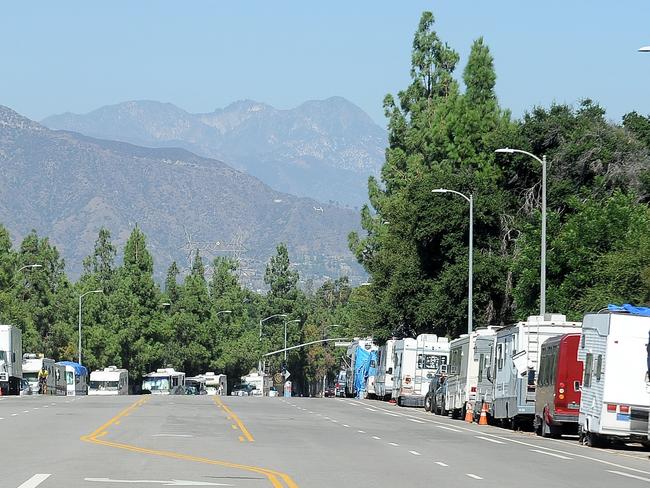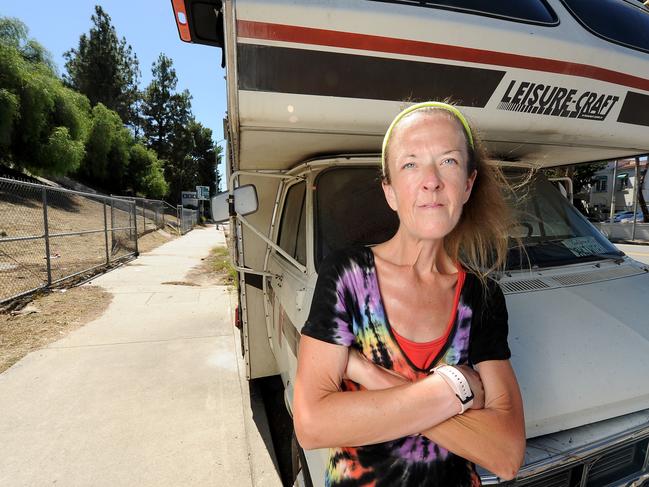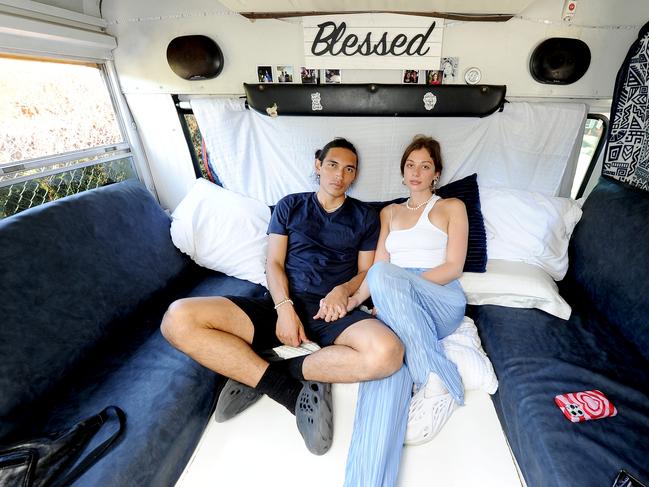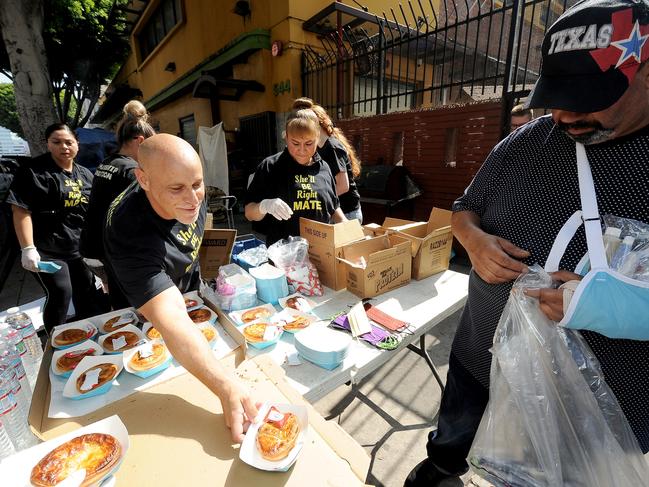The homelessness crisis gripping California – and what Australia must do to avoid the same fate
Australia has been warned to act urgently on its housing crisis, with fears homelessness rates could surge. Watch the video.

Property
Don't miss out on the headlines from Property. Followed categories will be added to My News.
Australia must fast-track construction of new housing to prevent a repeat of California’s vagrancy crisis in our cities, according to one of America’s leading homelessness experts.
Dr Margot Kushel, fresh from spearheading the largest US homelessness study in decades, has sounded the alarm about Australia’s housing headache with a blunt warning: “Don’t become us.”
There are 171,000 homeless people in California – enough to fill the SCG, Adelaide Oval, Melbourne’s AAMI Park, and the Gabba in Brisbane – who have been forced on to the streets by skyrocketing prices.
In the Golden State’s biggest cities, downtown blocks have turned into slums filled with tents while suburban roads are lined by campervans rented to the homeless by dodgy “van lords”.

Dr Kushel, the director of the University of California San Francisco’s Benioff Homelessness and Housing Initiative, said the “terrible situation” was tearing communities apart.
“Australia has a problem but they don’t have a problem as bad as we have,” she said.
“They want to do everything in their power to stop being us.”
“Trust us from what we’ve learned the hard way: once people become homeless, it’s so much harder to solve the problem.”
The median monthly rent for a one-bedroom apartment is $US3000 ($A4647) in San Francisco and $2400 ($A3717) in Los Angeles, according to rental platform Zumper, putting both cities in the top ten across the US.
That compares to $2890 across all units in Sydney, $2348 in Brisbane, $2283 in Melbourne and $1898 in Adelaide, SQM Research data shows.

Dr Kushel said the key finding of her study, which surveyed almost 3200 homeless people in California, was that the cost of housing was the dominant factor pushing them on the streets.
“Even for the people with mental health and substance abuse problems, these people were living with these problems … until they couldn’t pay the rent,” she said.
Those surveyed had a median monthly household income of $US960 ($A1487) in the six months prior to homelessness. Those who had been renting had a monthly income of $US1400 ($A2168) and were spending $700 ($A1084) on housing.
“It was really a story of people falling further and further and further behind,” Dr Kushel said.
“Once people lost that housing, the next housing was worse, since the costs keep going up and up and up … They’re one little disaster away from not being able to afford it.”
Asked for her advice for Australia, she said: “It’s not rocket science. It’s creating the housing that people can afford.”

“They want to get at the roots of the problem and they want to avoid getting into this cycle where they’re spending all their money managing a crisis,” Dr Kushel said.
While the Californian government has invested $US17.5bn ($A27.1bn) to combat homelessness over the past four years, the state’s homeless population has actually increased, even though that money could technically have covered all their rental costs.
Half of America’s unsheltered population is now in California.
Dr Kushel, who has studied homelessness since the 1990s, said the state’s housing costs had “really disconnected from wages for low-paid work and government benefits” since that time because supply had not kept pace with demand.
“This is a problem happening to very poor people,” she said.
“What I’m worried about is that this problem will creep higher and higher up the income scale if we keep not creating housing.”
HOW THE AMERICAN DREAM BECAME A NIGHTMARE
They call Los Angeles the City of Angels, but downtown in Skid Row, it’s more like hell.
The centre of America’s second largest city resembles a third world slum, with thousands of people living in tents between piles of rubbish, drug paraphernalia and human faeces.
Skid Row’s residents beg, borrow and steal. Some run naked in front of cars that dare pass through; others lie so still on the ground that it is not clear if they are even alive.
This has been LA’s dirty secret for decades, though the rise of fentanyl – the opioid which is the leading killer of Americans aged 18 to 45 – has certainly made it worse.

It has also morphed into the dominant caricature of homelessness in the United States: drug-addled and mentally ill people unwilling or unable to help themselves off the streets.
There is some truth in this image. But to see the full picture of the homelessness crisis, you need to travel across town to Forest Lawn Drive, the home of Hollywood’s biggest studios.
Parked between Universal and Warner Brothers are dozens of motorhomes and campervans. These are not fans camping out for a glimpse of their favourite celebrities, but Californians who cannot afford to live anywhere else.
An out-of-work actor waiting tables while the industry is on strike; a woman running her own business after being hit by a car; a model and a singer trying to realise their dreams. In a state where 171,000 people are homeless every night, they are the faces of this crisis, just as much as the residents of Skid Row.

It’s a similar story in San Francisco.
Homeless encampments fill the Tenderloin district, with drugs and crime making it a no-go zone in the heart of the city. Head into the suburbs, however, and you find streets lined with trailers and RVs, home to people locked out of one of America’s most expensive rental markets.
“For people who say we’re out here because we’re lazy or we’re just bums or we don’t care,” that’s not the situation,” says Ben Anguro-Navarrete.
“We’re not out here by choice.”
The 35-year-old has lived in a trailer with his wife Theresa since 2019.
His story before arriving in this industrial corner of San Francisco’s Bayview district typifies what leading US homelessness expert Dr Margot Kushel calls the “slow slide into homelessness”.
Anguro-Navarrete emigrated from Mexico as a child. His father was murdered after a stint in jail. His mother worked three jobs to raise him and his autistic brother, and he turned to crime to help pay the bills.

Eventually, as an adult, Anguro-Navarrete managed to have everything worked out.
“I did the 9-to-5, the whole family thing. Had a job, started my own business, had a house, front yard, dogs, pets, kids,” he says.
“Then times got tough and I went back to some dumb choices.”
Anguro-Navarrete went to prison. After he was released, he and his wife ran out of money to stay in motels, and they spent months in a tent before being offered a bed in a shelter. When Theresa’s mother fell ill, they had to leave to care for her, and despite informing the shelter, they lost their place and their belongings were thrown out.
That’s why Anguro-Navarrette says the trailer is “a blessing”.
But he cannot legally work because he cannot afford the fees to renew his US residency. That means an apartment is out of the question, and his two kids – aged nine and seven – must live with family interstate.
“It wouldn’t be fair to put them through what we’re dealing with,” he says, fighting back tears.
A few blocks away, motorcycle mechanic Rich Etchingham is tinkering in his bus. It is the eleventh he has had – a mobile home and a workshop for someone who has struggled to hold down a job.

Like Anguro-Navarrette, he is frustrated by the city’s support system which he says fails to deal with the root causes of homelessness and provide pathways to affordable housing, and instead revolves around drug addicts in the Tenderloin.
“I’d never live there, never, never, never, because it’s so bad,” Etchingham says.
Back in LA, the residents of Forest Lawn Drive similarly prefer their situation to Skid Row.
The middle-aged actor – who declines to be identified so his colleagues do not see his living situation – has been parked outside Warner Brothers since April last year. Authorities initially issued parking tickets before later sending rubbish crews to keep the area clean, pleasing the former Boy Scout who recycles, relies on candles for light, and showers at a nearby gym.
He was paying $US700 ($A1083) a month to rent his motorhome until he discovered his “van lord” had stolen his identity to claim welfare benefits.
Liberty V. Justice (who has legally changed her name) is charged slightly less for a campervan that “looked totally different” when she found it online. Nevertheless, she says it feels safer than a room she rented in an illegal share house. And after she was hit by a car last year, it is all she can afford while she recovers and works on her business.

“I’m just blessed to be alive,” Justice says. (As she talks, another recent crash victim – legendary talk show host Jay Leno – cruises past on his motorcycle.)
Down the road is Fabian Ancinez’s van, which he rented to a friend for 18 months while he chased modelling work in New York. He moved back to LA last month with his singer girlfriend Rachel Jones after signing with an agency.

Work is starting to flow, Ancinez says, but not enough to cover the $US1500 ($A2322) a month they need for a tiny studio apartment. Instead, the 27-year-olds make their roadside life as homely as possible with indoor plants, candles and a “blessed” sign over their bed.
There’s that word again. Across California, perhaps the homeless do still believe in the American Dream. But it looks very much like a nightmare.
AUSSIE SPIRIT HELPS SKID ROW RESIDENTS
Close your eyes, and you could be at a football game in Australia.
A man with a broad accent calls out: “Hot pies, get your hot pies.” The scent of meat, gravy and pastry hits your nostrils.

Open your eyes, however, and you are confronted with a scene that is foreign to Australia.
Skid Row is the epicentre of Los Angeles’ homelessness crisis. It’s a shocking scene – and that’s why expats Shayne Evans and Jay Jay Wolfpie decided to help.
They recently established The Mateship Foundation to formalise a volunteering mission they started in 2018. Wolfpie, owner of the Aussie Pies and Sausages bakery, was giving out pies to the homeless when Evans joined to distribute hygiene kits.

They now assist hundreds of people a month with a crew of Australian volunteers – dressed in T-shirts saying “she’ll be right mate” – and even more bankrolling their effort. Evans dances and hugs those she meets, while Wolfpie even doles out dollar bills.
It’s not an easy task. Evans says they are regularly confronted by drugs and crime, and once had a machete pulled on them. But their homeless regulars came to their aid.
“The first time I came down here, I was blown away,” the ex-Sydneysider says.
“But everyone’s happy to see us. Everyone’s got a story, everyone just wants a hug and a high five.”
Wolfpie says helping the homeless felt like what he had to do to “give back a little bit”.
“One moment in time, the Aussies make them happy.”
More Coverage
Originally published as The homelessness crisis gripping California – and what Australia must do to avoid the same fate




